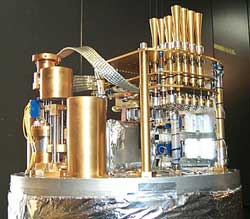Scientists use South Pole telescope to produce the most detailed images
of the early universe
13
December 2002
National
Science Foundation
Using a powerful
new instrument at the South Pole, a team of cosmologists has produced the
most detailed
images of the early universe ever recorded.
The research team,
which was funded by the National Science Foundation (NSF), has made public
their measurements
of subtle temperature differences
in the Cosmic Microwave Background (CMB) radiation. The CMB is the
remnant radiation that escaped from the rapidly cooling Universe
about 400,000 years after the Big Bang. Images of the CMB provide researchers
with a snapshot of the universe in its infancy, and can be used to
place strong constraints on its constituents and structure.
 |

The inner workings of the Arcminute Cosmology Bolometer Array Receiver
(ACBAR) include beam forming optics, filters and detectors. (Holzapfel
Group photos)
|
The new
results provide additional evidence to support the currently favored model
of the universe
in which 30 percent of all energy is a strange form of dark matter
that doesn’t interact with light and 65 percent is in an
even stranger form of dark energy that appears to be causing the
expansion
of the universe to accelerate. Only the remaining five percent
of the energy in the universe takes the form of familiar matter
like
that
which makes up planets and stars.
The researchers
developed a sensitive new instrument, the Arcminute Cosmology Bolometer
Array Receiver (ACBAR), to produce high-resolution
images of the CMB. ACBAR’s detailed images reveal the seeds that
grew to form the largest structures seen in the universe today. These
results add to the description of the early universe provided by several
previous ground-, balloon- and space-based experiments. Previous to
the ACBAR results, the most sensitive, fine angular scale CMB measurements
were produced by the NSF-funded Cosmic Background Investigator (CBI)
experiment observing from a mountaintop in Chile.
William
Holzapfel, of the University of California at Berkeley and ACBAR
co-principal investigator, said it is significant that the new
ACBAR results agree with those published by the CBI team despite the
very different instruments, observing strategies, analysis techniques
and sources of foreground emission for the two experiments. He added
that the new data provide a more rigorous test of the consistency of
the new ACBAR results with theoretical predictions.
“It
is amazing how precisely our theories can explain the behavior of
the universe when we know so little about the dark matter and dark
energy that comprise 95 percent of it,” said Holzapfel.
The dark
energy inferred from the ACBAR observations may be responsible for
the accelerating
expansion of the universe. “It is compelling
that we find, in the ancient history of the universe, evidence for
the same dark energy that supernova observations find more recently,” said
Jeffrey Peterson of Carnegie Mellon University.
The construction
of the ACBAR instrument and observations at the South Pole were carried
out by a team of researchers from the University
of California, Berkeley, Case Western Reserve University, Carnegie
Mellon University, the California Institute of Technology, Jet Propulsion
Laboratory (JPL), and Cardiff University in the United Kingdom. Principal
investigators Holzapfel and John Ruhl at Case Western led the effort,
which built and deployed the instrument in only two years.
 |

The
Viper telescope at the National Science Foundation's South Pole
Station.
|
ACBAR is
specifically designed to take advantage of the unique capabilities
of the 2.1-meter Viper telescope, built primarily by Jeff
Peterson
and collaborators at Carnegie Mellon and installed by NSF and its
South Pole Station in Antarctica. The receiver is an array of 16 detectors
built by Cal Tech and the JPL that create images of the sky in 3-millimeter
wavelength bands near the peak in the brightness of the CMB. In order
to reach the maximum possible sensitivity, the ACBAR detectors are
cooled to two-tenths of a degree above absolute zero, or about –273
degrees Celsius (–459 Fahrenheit). ACBAR has just completed its
second season of observations at the South Pole. Researcher Mathew
Newcomb kept the telescope observing continuously during the six-month-long
austral winter, despite temperatures plunging below –73 degrees
Celsius (–100 Fahrenheit).
The construction
of ACBAR and Viper was funded as part of the NSF Center for Astrophysical
Research in Antarctica. The U.S. Antarctic
Program provides continuing support for telescope maintenance, observations
and data analysis. NSF’s Amundsen-Scott South Pole Station is
ideally suited for astronomy, especially observations of the CMB. The
station is located at an altitude of approximately 3,000 meters (10,000
feet), atop the Antarctic ice sheet. Water vapor is the principal cause
of atmospheric absorption in broad portions of the electromagnetic
spectrum from near infrared to microwave wavelengths. The thin atmosphere
above the station is extremely cold and contains almost no water vapor. "Our
atmosphere may be essential to life on Earth," said Ruhl, "but
we'd love to get rid of it. For our observations, the South Pole is
as close as you can get to space while having your feet planted firmly
on the ground."
Papers describing the ACBAR CMB angular power spectrum and the constraints
it places on cosmological parameters have been submitted to the Astrophysical
Journal for publication, and drafts
are available online.
|